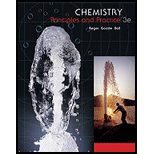
Concept explainers
Interpretation:
The pressure change in a tire inflated to
Concept Introduction:
For two gases that differs in the pressure, volume and temperature the combined
Here,
Pounds per square inch or
Answer to Problem 6.119QE
The pressure change in a tire inflated to
Explanation of Solution
The formula to convert degree Celsius to kelvin is as follows:
Here,
Substitute
Substitute
The formula to convert degree Celsius to kelvin is as follows:
Here,
Substitute
Substitute
The conversion factor to convert pounds per square inch to
Hence
If the volume of inflation is same then combined gas law can also be written as follows:
Here,
Substitute
Rearrange the expression to calculate the value of
The expression to calculate the change in pressure is given as follows:
Substitute
Want to see more full solutions like this?
Chapter 6 Solutions
Chemistry
- A sample of carbon monoxide was collected over water at a total pressure of 756 torr and a temperature of 18 °C. What is the pressure of the carbon monoxide? (See Table 9.2 for the vapor pressure of water.)arrow_forwardHelium condenses to a liquid at 4.224 K under atmospheric pressure and remains a liquid down to the absolute zero of temperature. (It is used as a coolant to reach very low temperatures.) The vapor pressure of liquid helium at 2.20 K is 0.05256 atm. Calculate the volume occupied by 1.000 mol helium vapor under these conditions and compare it with the volume of the same amount of helium at standard temperature and pressure.arrow_forward
 Chemistry: Principles and PracticeChemistryISBN:9780534420123Author:Daniel L. Reger, Scott R. Goode, David W. Ball, Edward MercerPublisher:Cengage LearningChemistry: Matter and ChangeChemistryISBN:9780078746376Author:Dinah Zike, Laurel Dingrando, Nicholas Hainen, Cheryl WistromPublisher:Glencoe/McGraw-Hill School Pub Co
Chemistry: Principles and PracticeChemistryISBN:9780534420123Author:Daniel L. Reger, Scott R. Goode, David W. Ball, Edward MercerPublisher:Cengage LearningChemistry: Matter and ChangeChemistryISBN:9780078746376Author:Dinah Zike, Laurel Dingrando, Nicholas Hainen, Cheryl WistromPublisher:Glencoe/McGraw-Hill School Pub Co Chemistry for Engineering StudentsChemistryISBN:9781337398909Author:Lawrence S. Brown, Tom HolmePublisher:Cengage Learning
Chemistry for Engineering StudentsChemistryISBN:9781337398909Author:Lawrence S. Brown, Tom HolmePublisher:Cengage Learning Introductory Chemistry: An Active Learning Approa...ChemistryISBN:9781305079250Author:Mark S. Cracolice, Ed PetersPublisher:Cengage Learning
Introductory Chemistry: An Active Learning Approa...ChemistryISBN:9781305079250Author:Mark S. Cracolice, Ed PetersPublisher:Cengage Learning Chemistry by OpenStax (2015-05-04)ChemistryISBN:9781938168390Author:Klaus Theopold, Richard H Langley, Paul Flowers, William R. Robinson, Mark BlaserPublisher:OpenStax
Chemistry by OpenStax (2015-05-04)ChemistryISBN:9781938168390Author:Klaus Theopold, Richard H Langley, Paul Flowers, William R. Robinson, Mark BlaserPublisher:OpenStax Chemistry & Chemical ReactivityChemistryISBN:9781337399074Author:John C. Kotz, Paul M. Treichel, John Townsend, David TreichelPublisher:Cengage Learning
Chemistry & Chemical ReactivityChemistryISBN:9781337399074Author:John C. Kotz, Paul M. Treichel, John Townsend, David TreichelPublisher:Cengage Learning





